Oil Spill Detection and Mapping Using Sentinel 2 Imagery
Abstract
:1. Introduction
2. Materials and Methods
2.1. Study Areas
2.2. Datasets
2.3. The Developed Methodology
- Level-1 segmentation (small objects)
- Weight for high resolution (10 m) bands 2, 3, 4, and 8:1
- Weight for lower resolution (60 and 20 m) bands 1, 9, and 11:0
- Scale 10, color 0.8—shape 0.2, compactness 0.5—smoothness 0.5
- Level-2 segmentation (large objects)
- Weight for high resolution (10 m) bands 2, 3, 4, and 8:1
- Weight for lower resolution (60 and 20 m) bands 1, 9, and 11:0
- Scale 80, color 0.1—shape 0.9, compactness 1.0—smoothness 0.0
3. Results
4. Discussion
5. Conclusions
Acknowledgments
Author Contributions
Conflicts of Interest
References
- Brown, H.M.; Bittner, J.P.; Goodman, R.H. The Limits of Visibility of Spilled Oil Sheens. In Proceedings of the Erim Conferences, Second Thematic International Airborne Remote Sensing Conference and Exhibition, San Francisco, CA, USA, 24–27 June 1996; Volume III, p. 327. [Google Scholar]
- Klemas, V. Tracking Oil Slicks and Predicting their Trajectories Using Remote Sensors and Models: Case Studies of the Sea Princess and Deepwater Horizon Oil Spills. J. Coast. Res. 2010, 26, 789–797. [Google Scholar] [CrossRef]
- Karathanassi, V. Spectral Unmixing Evaluation for Oil Spill Characterization. Int. J. Remote Sens. Appl. 2014, 4. [Google Scholar] [CrossRef]
- Clark, R.N.; Swayze, G.A.; Leifer, I.; Livo, K.E.; Lundeem, S.; Eastwood, M.; Green, R.O.; Kokaly, R.; Hoefen, T.; Sarture, C.; et al. A Method for Qualitative Mapping of Thick Oil Using Imaging Spectroscopy; United States Geological Survey: Reston, GA, USA, 2010. Available online: http://pubs.usgs.gov/of/2010/1101 (accessed on 11 October 2017).
- Hu, C.; Weisberg, R.H.; Liu, Y.; Zheng, L.; Daly, K.L.; English, D.C.; Zhao, J.; Vargo, G.A. Did the northeastern Gulf of Mexico become greener after the Deepwater Horizon oil spill? Geophys. Res. Lett. 2011, 38, L09601. [Google Scholar] [CrossRef]
- Carnesecchi, F.; Byfield, V.; Cipollini, P.; Corsini, G.; Diani, M. An optical model for the interpretation of remotely sensed multispectral images of oil spill. In Proceedings of the SPIE 2008, Remote Sensing of the Ocean, Sea Ice, and Large Water Regions, Cardiff, UK, 15–18 September 2008; Volume 7105. [Google Scholar] [CrossRef]
- Zhao, J.; Temimi, M.; Ghedira, H.; Hu, C. Exploring the potential of optical remote sensing for oil spill detection in shallow coastal waters—A case study in the Arabian Gulf. Opt. Express 2014, 22, 13755–13772. [Google Scholar] [CrossRef] [PubMed]
- Lee, M.S.; Park, K.A.; Lee, H.R. Detection and dispersion of oil spills from satellite optical images in a coastal bay. In Proceedings of the 2016 IEEE International Geoscience and Remote Sensing Symposium (IGARSS), Beijing, China, 10–15 July 2016. [Google Scholar]
- Taravat, A.; Del Frate, F. Development of band ratioing algorithms and neural networks to detection of oil spills using Landsat ETM+ data. EURASIP J. Adv. Signal Process. 2012, 2012, 107. [Google Scholar] [CrossRef]
- Bradford, N.B.; Sanchez-Reyes, P.J. Automated oil spill detection with multispectral imagery. In Proceedings of the SPIE 8030, Ocean Sensing and Monitoring III, Orlando, FL, USA, 25–29 April 2011; Volume 8030. [Google Scholar] [CrossRef]
- Corucci, L.; Nardellib, F.; Cococcionia, M. Oil Spill Classification from Multi-Spectral Satellite Images: Exploring Different Machine Learning Techniques. In Proceedings of the Remote Sensing of the Ocean, Sea Ice, and Large Water Regions 2010, Toulouse, France, 20–23 September 201.
- Karathanassi, V.; Topouzelis, K.; Pavlakis, P.; Rokos, D. An object-oriented methodology to detect oil spills. Int. J. Remote Sens. 2006, 27, 5235–5251. [Google Scholar] [CrossRef]
- Lang, H.; Zhang, X.; Xi, Y.; Zhang, X.; Li, W. Dark-spot segmentation for oil spill detection based on multi-feature fusion classification in single-pol synthetic aperture radar imagery. J. Appl. Remote Sens. 2017, 11, 015006. [Google Scholar] [CrossRef]
- Su, T.F.; Li, H.Y.; Liu, T.X. Sea Oil Spill Detection Method Using SAR Imagery Combined with Object-Based Image Analysis and Fuzzy Logic. Adv. Mater. Res. 2015, 1065–1069, 3192–3200. [Google Scholar] [CrossRef]
- Chen, Z.; Wang, C.; Teng, X. Oil spill detection based on a superpixel segmentation method for SAR image. In Proceedings of the2014 IEEE International Geoscience and Remote Sensing Symposium (IGARSS), Quebec City, QC, Canada, 13–18 July 2014. [Google Scholar]
- Topouzelis, K.; Kitsiou, D. Detection and classification of mesoscale atmospheric phenomena above sea in SAR imagery. Remote Sens. Environ. 2015, 160, 263–272. [Google Scholar] [CrossRef]
- Topouzelis, K. Oil spill detection by SAR images: Approaches and Algorithms. Invited paper for the special issue: Synthetic Aperture Radar (SAR). Sensors 2008, 8, 6642–6659. [Google Scholar] [CrossRef] [PubMed] [Green Version]
- Maianti, P.; Rusmini, M.; Tortini, R.; Gianinetto, M. Monitoring large oil slick dynamics with moderate resolution multispectral satellite data. Nat. Hazards 2014, 73, 473–492. [Google Scholar] [CrossRef]
- Kolokoussis, P.; Karathanassi, V. Detection of Oil Spills and Underwater Natural Oil Outflow Using Multispectral Satellite Imagery. Int. J. Remote Sens. Appl. 2013, 3, 145–154. [Google Scholar]
- Reiche, J.; Hese, S.; Schmullius, C. Objektbasierte Klassifikation terrestrischer Ölverschmutzungen mittel shochauflösender Satellitendaten in West-Sibirien. Photogramm. Fernerkund. Geoinf. 2017, 11, 275–288. [Google Scholar]
- Liu, Y.; MacFadyen, A.; Ji, Z.G.; Weisberg, R.H. (Eds.) Monitoring and Modeling the Deepwater Horizon Oil Spill: A Record-Breaking Enterprise; Geophysical Monograph Series; AGU/Geopress: Washington, DC, USA, 2011; Volume 195, p. 271. [Google Scholar]
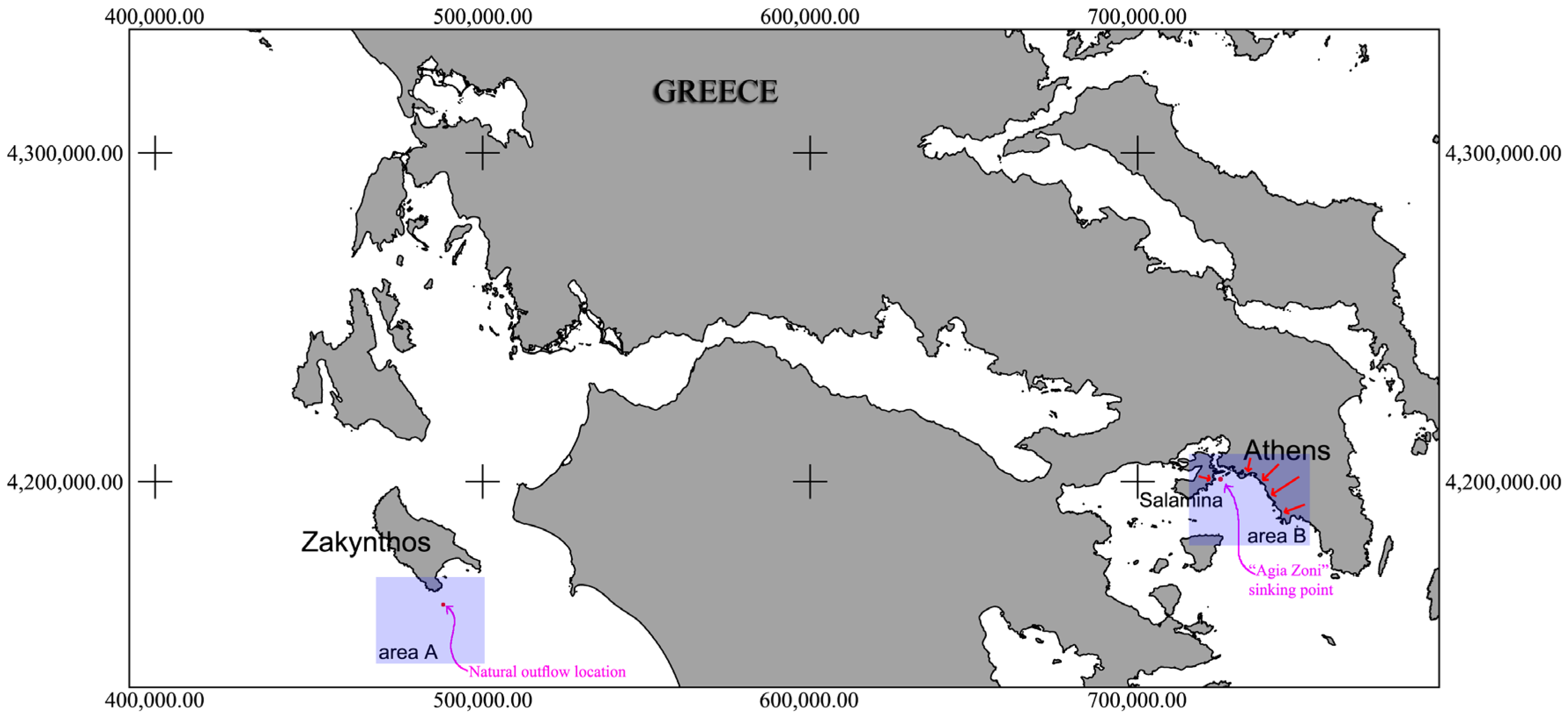

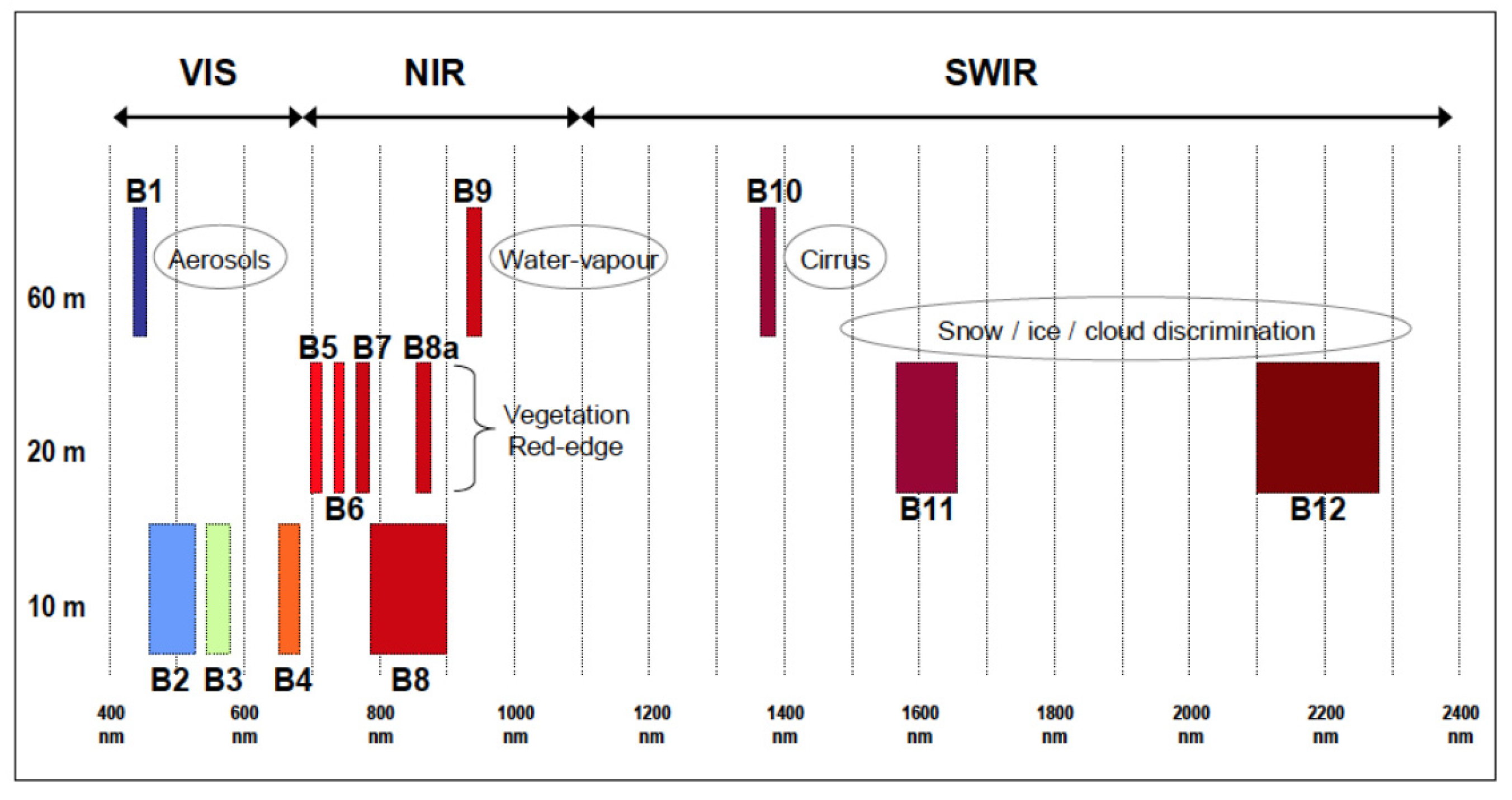

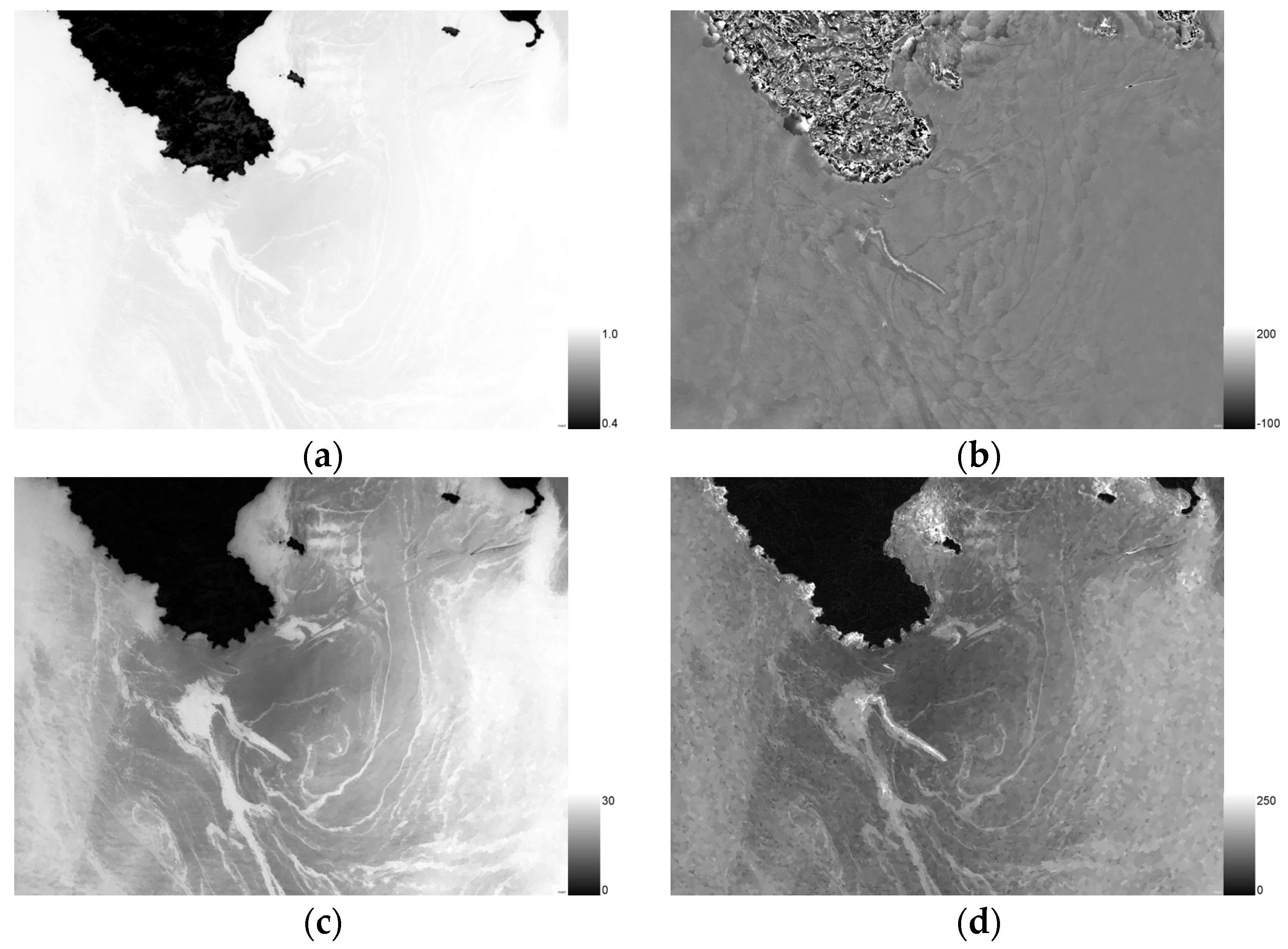
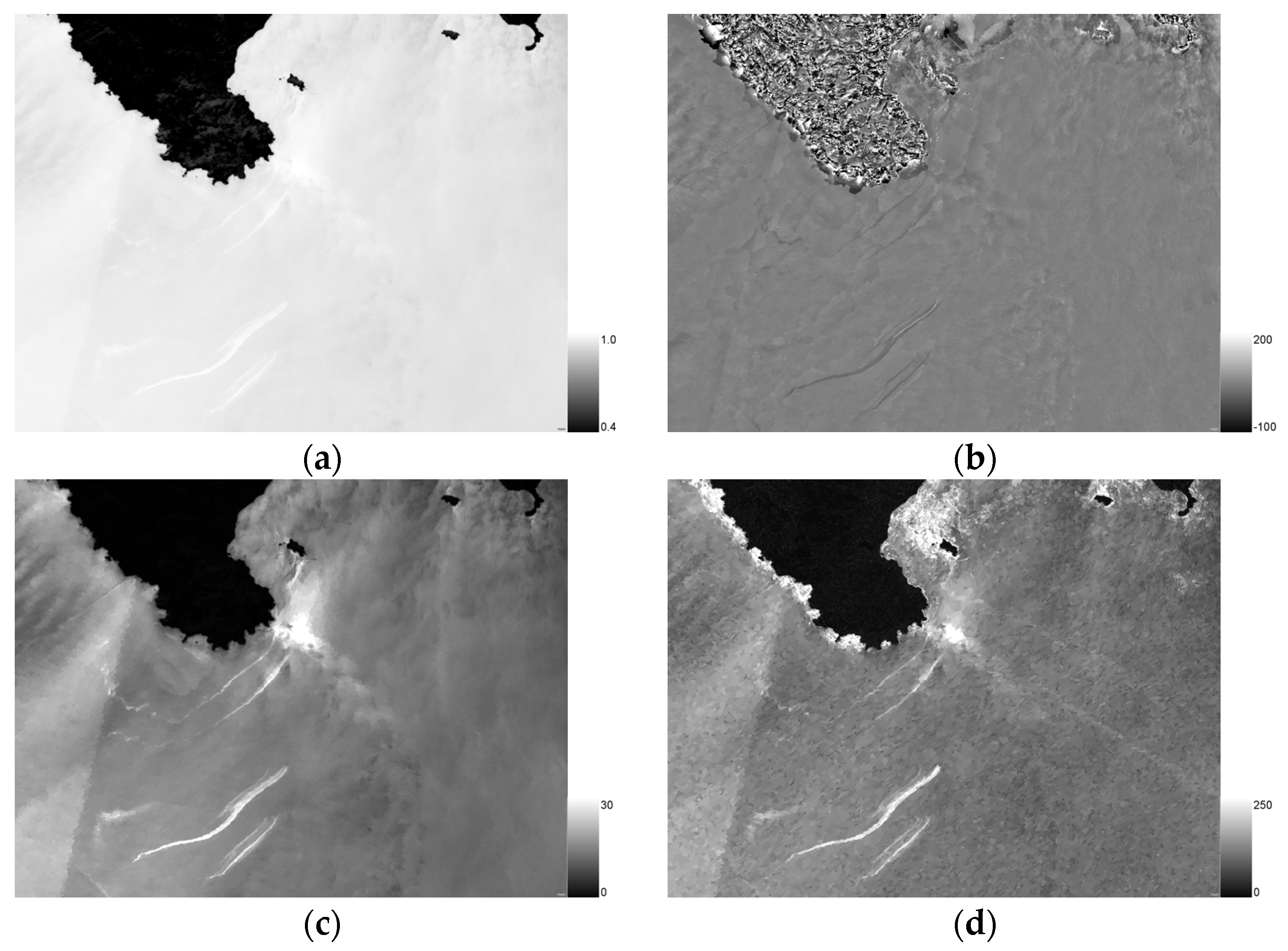
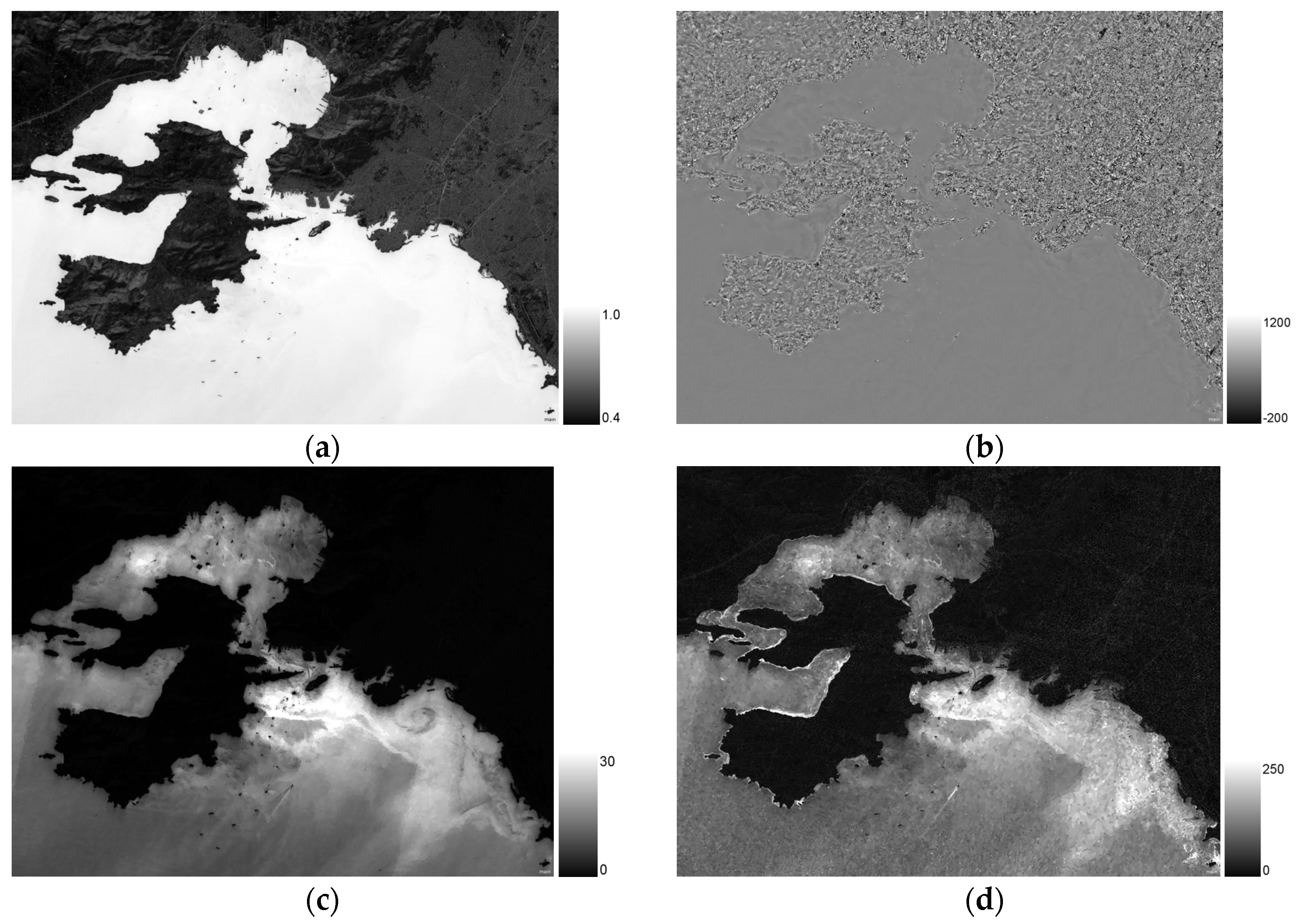
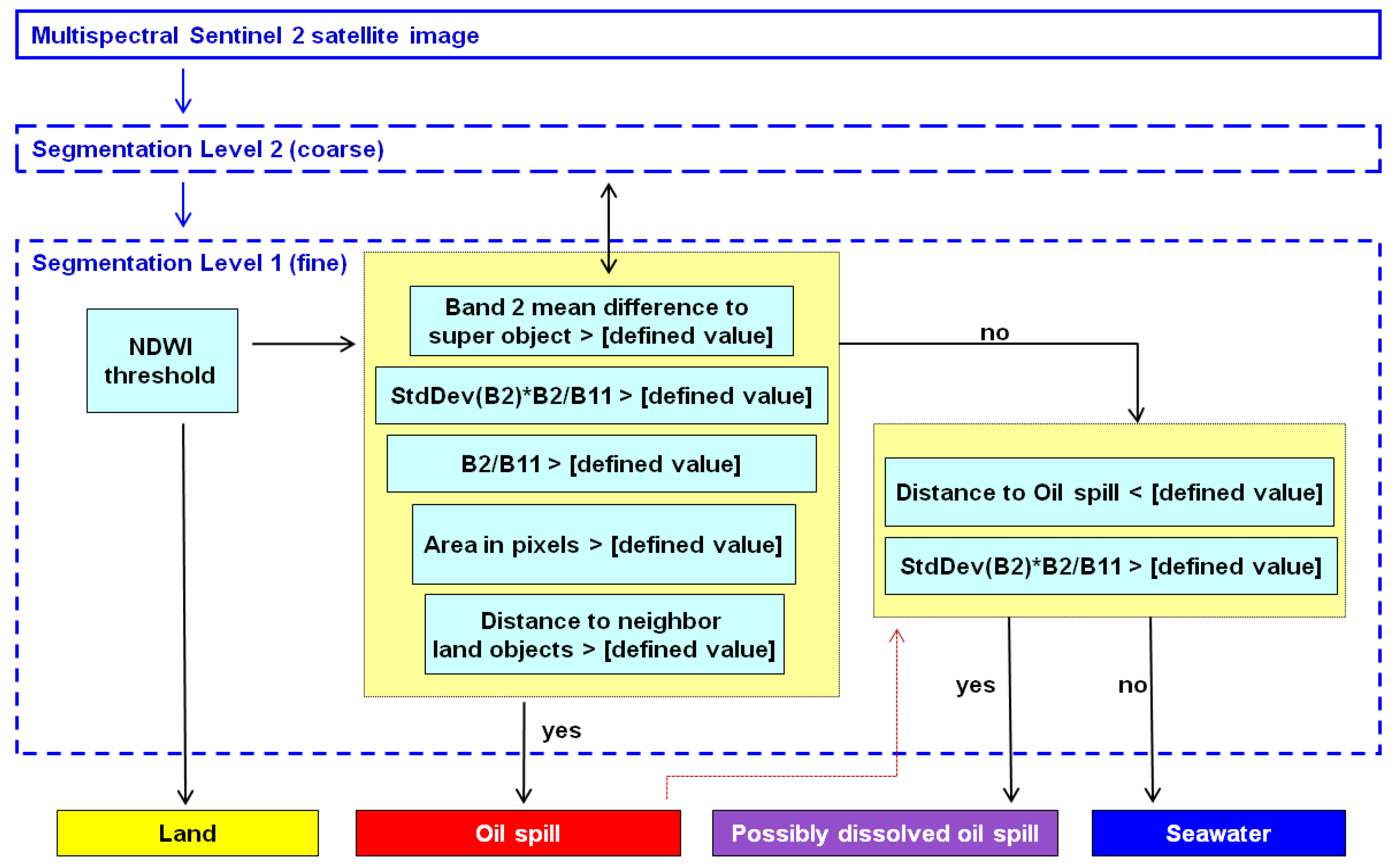
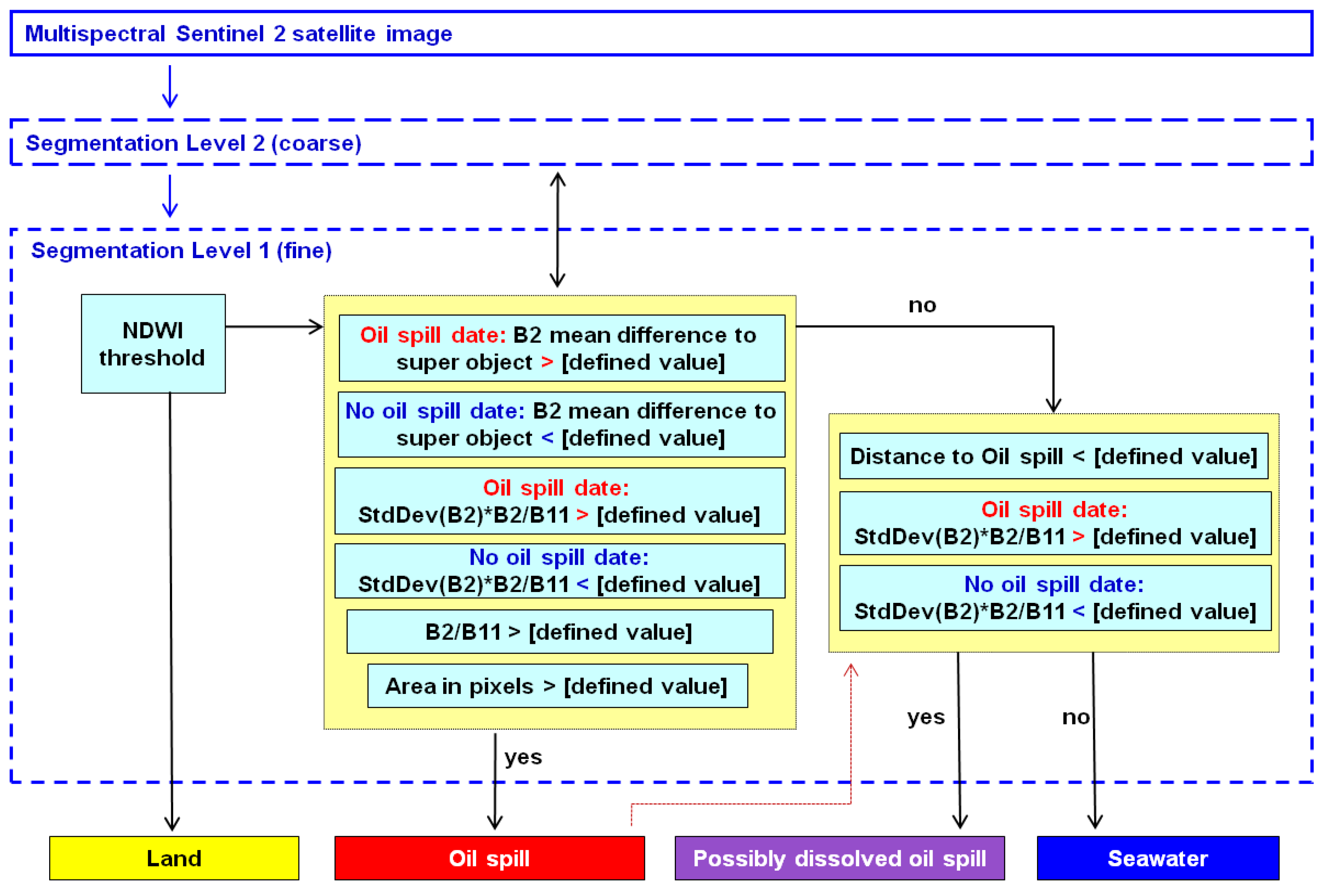

| Geographic Area | Date | Sentinel Satellite | Sentinel-2 Image |
|---|---|---|---|
| Zakynthos | 7 August 2017 | 2A | L1C_T34SDG_A011101_20170807T092725 |
| Zakynthos | 27 August 2017 | 2A | L1C_T34SDG_A011387_20170827T092818 |
| Salamina | 13 September 2017 | 2A | L1C_T34SGH_A011630_20170913T091832 |
| Salamina | 8 September 2017 | 2B | L1C_T34SGH_A002650_20170908T091906 |
| Salamina | 15 September 2017 | 1A | S1A_IW_GRDH_1WDV_20170915T042323 _20170915T042348_018381_01EF05_7D8E |
| Class | Feature | Decision Value | Fuzzy Limits |
|---|---|---|---|
| Seawater | NDWI | >0.4 | 0.35  0.45 0.45 |
| Oil spill | B2 mean difference to super objects | >11 | 10  12 12 |
| StdDev(B2)*B2/B11 | >135 | 130  140 140 | |
| B2/B11 | >13 | 12  14 14 | |
| Area in pixels | >20 | 19  21 21 | |
| Distance to Land objects (meters) | >350 | 300  400 400 | |
| Possibly dissolved oil spill | Distance to oil spill (meters) | <275 | 250  300 300 |
| StdDev(B2)*B2/B11 | >125 | 120  130 130 |
| Class | Feature | Decision Value | Fuzzy Limits |
|---|---|---|---|
| Seawater | NDWI | >0.4 | 0.35  0.45 0.45 |
| Oil spill | B2 mean diff. to sup. obj. (oil spill date) | >11 | 10  12 12 |
| B2 mean diff. to sup. obj. (no oil spill date) | <11 | 10  12 12 | |
| StdDev(B2)*B2/B11 (oil spill date) | >135 | 130  140 140 | |
| StdDev(B2)*B2/B11 (no oil spill date) | <135 | 130  140 140 | |
| B2/B11 | >13 | 12  14 14 | |
| Area in pixels | >20 | 19  21 21 | |
| Possibly dissolved oil spill | Distance to oil spill (meters) | <275 | 250  300 300 |
| StdDev(B2)*B2/B11 (oil spill date) | >125 | 120  130 130 | |
| StdDev(B2)*B2/B11 (no oil spill date) | <135 | 130  140 140 |
© 2018 by the authors. Licensee MDPI, Basel, Switzerland. This article is an open access article distributed under the terms and conditions of the Creative Commons Attribution (CC BY) license (http://creativecommons.org/licenses/by/4.0/).
Share and Cite
Kolokoussis, P.; Karathanassi, V. Oil Spill Detection and Mapping Using Sentinel 2 Imagery. J. Mar. Sci. Eng. 2018, 6, 4. https://doi.org/10.3390/jmse6010004
Kolokoussis P, Karathanassi V. Oil Spill Detection and Mapping Using Sentinel 2 Imagery. Journal of Marine Science and Engineering. 2018; 6(1):4. https://doi.org/10.3390/jmse6010004
Chicago/Turabian StyleKolokoussis, Polychronis, and Vassilia Karathanassi. 2018. "Oil Spill Detection and Mapping Using Sentinel 2 Imagery" Journal of Marine Science and Engineering 6, no. 1: 4. https://doi.org/10.3390/jmse6010004





